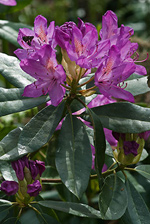|
||||||
|
RHODODENDRON. Rhododendrons. [Ericaceae] |
|
|
Seven species of Rhododendron are recorded in Britain. All are introduced. Only one British miner is recorded on Rhododendron. A key to the European miners recorded on Rhododendron is provided in Bladmineerders van Europa. |
|
|
Key for the identification of the known mines of British |
1 > Leaf-miner: The larvae initially form mines in leaves, later forming a cone by rolling the leaf downwards from the tip. Orange brown to rust-coloured lower-surface blotch, mostly near the midrib. Towards the end of the mining activity silk is deposited in the mine; this causes the mine to contract, folding the leaf over the mine. Frass packed in a corner of the mine. After some time the larva vacates the mine and lives free then in a leaf tip that has been rolled downwards and fixed with silk. Two of such cones are made and eaten out from the inside. Pupation in a membranous, shining cocoon at the underside of a leaf. |
|
Caloptilia azaleella (Brants, 1913) [Coleoptera: Chrysomelidae]. |
| Last updated 06-Jul-2019 Brian Pitkin | ||

